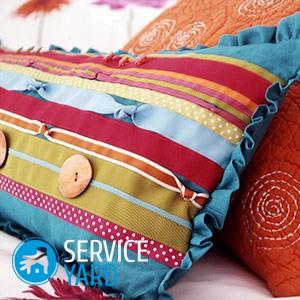DIY quilt

A quilt is an incredibly beautiful and practical thing. In addition, it is almost out of fashion. And a do-it-yourself quilt made by a skilled, diligent craftswoman will become a unique decoration for the bedroom and will warm you on a cool evening. If earlier, down-feather filler was used for such products, now synthetics are used (quilted batting, synthetic winterizer). It is advisable to sew such a product from natural fabric. We will deal with everything in order in this article.
to contents ↑What is useful for work?
Before stitching a quilt, prepare materials and tools. Useful for work:
- Material for the upper (beautiful compacted textiles).
- Chintz or calico for sewing the inside.
- Synthetic filler.
- For layout: chalk, tailor's ruler and square.
- Sewing supplies.
DIY quilt - master class, procedure
In this case, the pattern is not necessary. It will come in handy if you plan to sew the top of individual shreds.
Cutting material
Cut 4 parts, 2 parts from each type of textile.
Important! The specific dimensions depend on the size of the bed. At the same time, make parts for the inside slightly larger than for the outside.
The size difference depends on how thick the packing is. If you use batting in one layer as a packing, then the difference in size in length and width is approximately 100 mm. Do not forget about the 15 mm allowances for seams.
For the outer shell, you can use bright satin or satin. The choice of fabric for the inner part depends on the properties of the filler:
- If it is a synthetic winterizer, batting or cotton, then for the outer part of the blanket you can use calico, chintz or any cotton textile.
- A dense teak is best suited for down filler.
Cut out the rectangles from the filler. The size corresponds to the dimensions of the inside of the blanket, but excluding allowances for seams.
Important! Many fabrics sit down after wetting, therefore both cuts of textiles should be washed before cutting.
Product assembly
The build algorithm depends on which filler you use. First, consider how to sew a cotton blanket. Sintepon or batting use this way:
- Spread on the floor one of the panels of the outer part “face down”.
- Put one of the panels for the inner bag on it.
- The next will be a thermal insulation layer.
- Cover the filler with a second cloth of the inner bag.
- The upper part of the resulting “sandwich” is the front canvas, but already “face up”.
- Gently chop all the layers with safety pins or sweep them into several stitches through all the layers.
Important! Pull 2 cords between the opposite corners to check if the workpiece is made correctly.
Stitches pattern
The easiest option is to quilt the product with mutually perpendicular longitudinal and transverse lines. Lines can be directed obliquely.
Important! The complex pattern looks very nice. Chalk on top of the product. Start bonding layers, moving from the center to the edges.
Align the product at the edges using a ruler and a tailor's square. The ruler can be replaced with a long rail. Trim the edge with a hem. Its width is 16 cm, and the length corresponds to the perimeter of the product.
Features of the manufacture of duvets:
- Sew 2 bags: outer - satin, inner - teak.
- Put one bag in another.
- Mark with chalk and quilting longitudinal stripes. Get separate compartments.
- Fill them down to the first horizontal strip. Quilting.
- Next, follow the same algorithm.
- After the packing is finished, sew the teak bag first, then the satin bag.
Stock footage
As you can see, there is nothing complicated in how to sew a quilt with your own hands. A little imagination, hard work, and you will certainly succeed perfectly!










